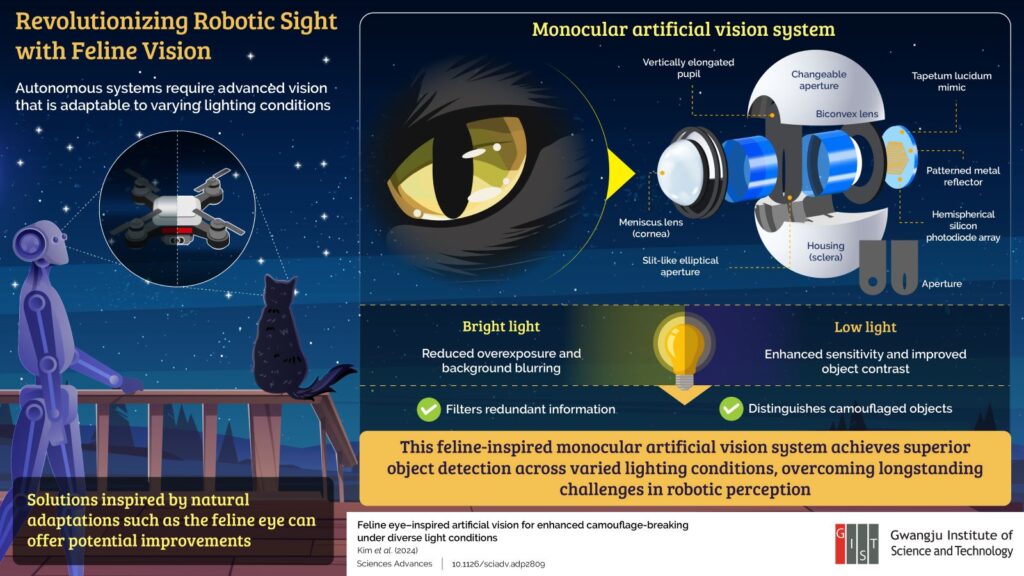Gwangju Institute of Science and Technology Researchers Develop Cat’s Eye-Inspired Vision System for Autonomous Robotics

This novel system features a slit-like elliptical aperture and a patterned metal reflector to improve object detection and recognition in various lighting conditions. The design effectively reduces light interference and enhances photosensitivity, enabling the detection of camouflaged objects in varying lightning. Image credit: Young Min Song from GIST, Korea.
Feline-inspired vision technology enhances accuracy in challenging environments, paving the way for smarter, more efficient autonomous systems
Researchers led by Professor Young Min Song from the Gwangju Institute of Science and Technology (GIST) have unveiled a vision system inspired by feline eyes to enhance object detection in various lighting conditions. Featuring a unique shape and reflective surface, the system reduces glare in bright environments and boosts sensitivity in low-light scenarios. By filtering unnecessary details, this technology significantly improves the performance of single-lens cameras, representing a notable advancement in robotic vision capabilities.
Autonomous systems like drones, self-driving cars, and robots are becoming more common in our daily lives. However, they often struggle to “see” well in different environments—like bright sunlight, low light, or when objects blend into complex backgrounds. Interestingly, nature may already have the solution to this problem.
Cats are known for their amazing vision in both bright light and darkness. Their eyes are uniquely adapted: during the day, vertical slit-shaped pupils help them focus and reduce glare. At night, their pupils widen to let in more light, and a reflective layer called the tapetum lucidum boosts their night vision, giving their eyes that familiar glow.
A group of Korean researchers led by Professor Young Min Song from Gwangju Institute of Science and Technology (GIST) designed a new vision system that uses an advanced lens and sensors inspired by feline eyes. The system includes a slit-like aperture that, like a cat’s vertical pupil, helps filter unnecessary light and focus on key objects. It also uses a special reflective layer similar to the one found in cat eyes that improves visibility in low-light conditions. This research was published in the journal Science Advances on September 18, 2024, and represents a significant advancement in artificial vision systems, demonstrating enhanced object detection and recognition capabilities and positioning it at the forefront of technological breakthroughs in autonomous robotics.
“Robotic cameras often struggle to spot objects in busy or camouflaged backgrounds, especially when lighting conditions change. Our design solves this by letting robots blur out unnecessary details and focus on important objects,” explains Prof. Song. This approach has the additional benefit of being energy-efficient, as it relies on the design of the lens rather than on heavy computer processing.
This groundbreaking technology unlocks exciting possibilities for real-world applications, transforming the landscape of robotic vision. The advanced vision system promises to elevate the precision of drones, security robots, and self-driving vehicles, enabling them to adeptly navigate intricate environments and execute tasks with unparalleled accuracy. “From search-and-rescue operations to industrial monitoring, these cutting-edge robotic eyes stand ready to complement or even replace human efforts in a variety of critical scenarios,” emphasizes Prof. Song.
Reference
Title of original paper: Feline eye–inspired artificial vision for enhanced camouflage breaking under diverse light conditions
Journal: Science Advances
DOI: https://doi.org/10.1126/sciadv.adp2809
About the institute
The Gwangju Institute of Science and Technology (GIST) was founded in 1993 by the Korean government as a research-oriented graduate school to help ensure Korea’s continued economic growth and prosperity by developing advanced science and technology with an emphasis on collaboration with the international community. Since that time, GIST has pioneered a highly regarded undergraduate science curriculum in 2010 that has become a model for other science universities in Korea. To learn more about GIST and its exciting opportunities for researchers and students alike, please visit: http://www.gist.ac.kr/.
About the author
Professor Young Min Song is a distinguished professor in the School of Electrical Engineering and Computer Science at GIST. His research specializes in multifunctional nanophotonics, advanced optoelectronic devices, and bioinspired imaging systems, drawing inspiration from the eyes of various species, including fish, fiddler crabs, cuttlefish, and birds. He obtained both his M.S. and Ph.D. in Information and Communications from the Gwangju Institute of Science and Technology (GIST) in 2006 and 2011, respectively. Following his doctoral studies, he served as a postdoctoral researcher in Materials Science and Engineering at the University of Illinois at Urbana-Champaign from 2011 to 2013.